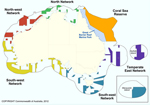Australia Creates World's Largest System of Marine Parks
The Australian government has formally proclaimed the world's largest system of marine parks around its coastline.
“Today marks a turning point for the protection of Australia's oceans,” said Imogen Zethoven of the Pew Environment Group. “Australians have always had a special relationship with our oceans, and with today's proclamation, we regain our position as a world leader in marine protection. Australians have said yes to a better balance between what we take from the oceans and what we conserve for the future.”
Click for official maps of the new marine park system
Establishment of the Coral Sea Marine Reserve of 989,842 square kilometers (382,180 square miles) creates a large, highly protected sanctuary zone of 502,238 square kilometers (193,915 square miles). Called the Coral Sea Marine National Park, it is the world's second-largest highly protected marine reserve. (The world's largest is the Chagos Marine Reserve, surrounding a British overseas territory in the Indian Ocean, which Pew played a leading role in establishing in 2010). The Coral Sea Marine National Park is the largest highly protected sanctuary within a country's domestic exclusive economic zone.
“The creation of a national network of marine parks is the culmination of a 14-year-long journey that began in 1998 as a Howard government initiative,” said Michelle Grady, of the Pew Environment Group. “During the past four years, Australians have consistently shown clear and overwhelming support for safeguarding our important marine areas. Marine parks will provide long-term benefits to conservation, science, and tourism.”
Australia's marine science community has heralded the action because it will lead to greater scientific discoveries and possible medical breakthroughs.
"The huge system of marine parks will build additional resistance and resilience for fish stocks, and protect fragile and critical habitats such as shallow and deep coral reefs while conserving a wealth of marine biodiversity in Australia's waters," said Professor Ove Hoegh-Guldberg, director of the Global Change Institute at the University of Queensland. "This network will provide the most efficient tool for understanding the effects of fishing and environmental change on marine biodiversity. So little is still known about our oceans and new discoveries occur regularly. This will only increase as science research expands to take advantage of the opportunities for discovery in the new national system of marine parks."
The first comprehensive Census of Marine Life published in 2010, revealed that as much as 80 per cent of marine life in Australia's oceans is yet to be named.
Hoegh-Guldberg is leading the Catlin Seaview Survey, the first survey of both shallow and deep corals of the Great Barrier Reef and Coral Sea. Expedition teams will visit 20 reefs to research and record the shallow areas (0-12m) as well as relatively unknown deep areas (30-100m).
This project is collecting thousands of images of the reefs, allowing viewers from all around the globe to take a Google's Street View tour of these iconic reefs.













